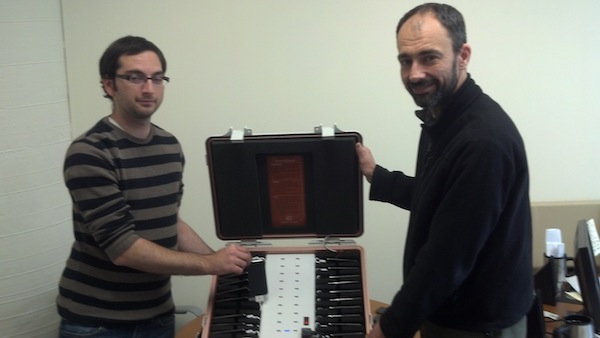
A peek inside the Philadelphia Orchestra’s iNotes app
By Vincent Geels, The Philadelphia Orchestra
The goal of any successful web program, application, or piece of technology is for the end-user’s experience to be seamless when interacting with the technology. When your web browser starts to get choppy or grinds to a halt, it’s almost as if you snap out of a trance: The once-discreet operations running in the background make themselves readily apparent and leave you frustrated, your experience interrupted.
The same goes for mobile apps. The internal mechanics and external logistics that go into our iNotes mobile app are relatively complex, and the Orchestra’s IT staff and Drexel’s engineers deserve a lot of credit for everything they do to, well, make their work and these mechanics look invisible. I recently spoke with Matt Prockup, Drexel graduate student and member of the MET Lab, and Ezra Wiesner, Philadelphia Orchestra senior director of technology infrastructure, about some of the nittier and grittier aspects of what it takes to implement and support various aspects of iNotes.
First and foremost is the audio-tracking feature that is the core of this app. The genesis of iNotes audio tracking in Verizon Hall is simple, says Matt: “There’s a single microphone in the hall that picks up the performance. It’s a simple audio feed that relays information to a tracking server, which in turn aligns the live audio with a previously annotated recording of the same work.” From here it gets a bit more tricky. Which recording do you use of, say, Beethoven’s Ninth Symphony, a work for which there are likely hundreds? And how does the annotation process work?
It turns out these things are currently done the old-fashioned way. Matt requests the score of the work from the Orchestra’s artistic department, and subsequently digitally recreates each individual measure number in a potential reference recording (this process of recreating measures provides the necessary reference points for time-specific information to pop up when using the iNotes app). He often repeats this process for another four candidate recordings, cross-referencing them against one another to determine which one tracks the rest most accurately on a consistent basis. The result is an audio reference that maintains a high degree of accuracy against live performances no matter the tempo, style, or interpretation.
Then there’s the actual delivery of the multimedia content to a user’s smartphone when they’re experiencing the performance in Verizon Hall. Ezra and Matt explained that they use a multicast network delivery system in the hall for iNotes which, in short, is a very efficient way of distributing information to lots of users in a network—especially high-bandwidth content like video. Still, even the most efficient network ever created wouldn’t be of much use if a user couldn’t connect to it from where they’re seated. “Just because we’re testing the app on smartphones in a controlled number of locations doesn’t mean that we want to technically limit roll-out down the road,” says Ezra, so he actually surveys and records network strength by sitting and testing it all over Verizon Hall.
With the next major iNotes test scheduled for the Orchestra’s Elektra concerts on May 10 and 12, the team is brainstorming and preparing for the inevitable logistical and operations hurdles that accompany any large-scale test. Nevertheless, it’s the day-to-day maintenance that ensures that, when it comes to show time, the iNotes user can focus on enjoying the app and the performance—both without interruption.
Recent Content
-
Artsarticle ·
-
Artsarticle ·
-
Artsarticle ·
